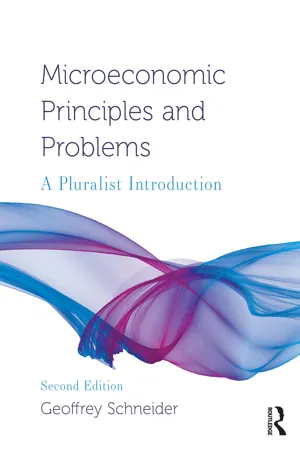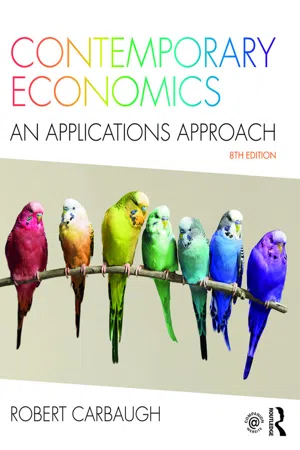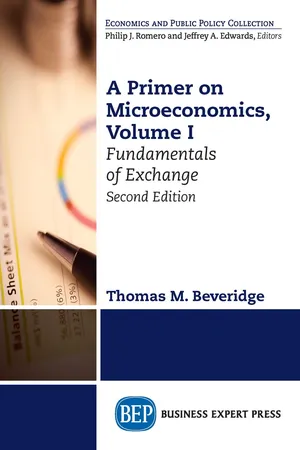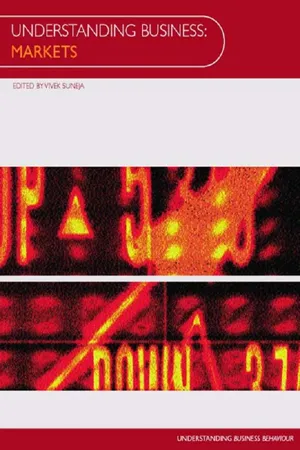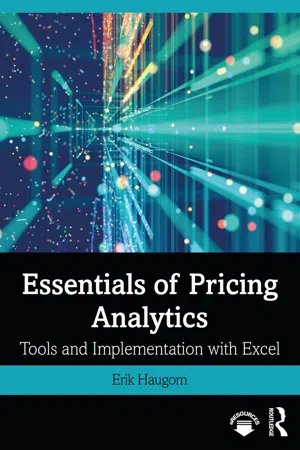Economics
Price Elasticity of Demand Formula
The price elasticity of demand formula measures the responsiveness of quantity demanded to a change in price. It is calculated by dividing the percentage change in quantity demanded by the percentage change in price. The formula helps to determine how sensitive consumers are to price changes for a particular good or service.
Written by Perlego with AI-assistance
Related key terms
12 Key excerpts on "Price Elasticity of Demand Formula"
- eBook - ePub
Microeconomic Principles and Problems
A Pluralist Introduction
- Geoffrey Schneider(Author)
- 2024(Publication Date)
- Routledge(Publisher)
Now that we have described how price floors, price ceilings, excise taxes, and per-unit subsidies affect the supply and demand model, we need to explore the topic of elasticity in more detail. Elasticity is an extremely useful concept for both consumers and producers to understand. It is particularly important for business owners trying to understand their consumer base and how they will respond to different pricing strategies.10.5 THE PRICE ELASTICITY OF DEMAND
Price elasticity of demand refers to the responsiveness of quantity demanded to changes in price. In mathematical terms, the price elasticity of demand, eD , is equal to the percentage change in the quantity demanded divided by the percentage change in price. The price elasticity of demand is less than or equal to zero, eD ≤ 0, because of the negative slope of the demand curve. In mathematical terms, the price elasticity of demand (eD ) can be written as follows:2e D==% ▵Q D% ▵ P=▵ QQ 1▵ PP 1(Q 2−Q 1)Q 1(P 2−P 1)P 110.5.1 Price inelastic demand
In general, a demand curve is said to be price inelastic if a change in price causes very little change in the quantity demanded. Inelastic demand curves tend to be steep. Notice that in the equation for the price elasticity of demand, if the percentage change in quantity is very small compared to the percentage change in price, we will get a fraction for eD because the numerator will be smaller than the denominator in absolute value. We use the absolute value to compare the magnitude of the change in price and the change in quantity demanded because one of the numbers will be negative given the negative slope of the demand curve. So, when the demand curve is price inelastic, the absolute value of the price elasticity of demand is between 0 and 1: 0 < |eD - Available until 20 Jul |Learn more
Contemporary Economics
An Applications Approach
- Robert Carbaugh(Author)
- 2016(Publication Date)
- Routledge(Publisher)
price elasticity of demand measures how responsive, or sensitive, buyers are to a change in price. The price elasticity of demand looks at the percentage change in quantity demanded relative to the percentage change in price. The elasticity formula isE d=Percentage change in quantity demanded Percentage change in pricewhere Ed is the elasticity coefficient.11 The midpoint formula is used to calculate the elasticity between two points on a demand curve (or supply curve). This formula uses the averages of the two quantities and the two prices under consideration as reference points. According to the midpoint formula, the percentage change in quantity equals the change in the quantity divided by the average of the two quantities; the percentage change in price equals the change in price divided by the average of the two prices. Therefore, the price elasticity of demand equals:Suppose that attendance at the Lakers’ games decreases by 10 percent when the price of tickets increases by 5 percent. Thus, the price elasticity of demand is 2:E d=Change in quantity÷Sum of quantities / 2Change in priceSum of prices / 2The value of the elasticity coefficient, 2, suggests that game attendance changes 2 percent for each 1-percent change in the price of a ticket.E d=10 percent change in quantity demanded 5 percent change in price= 2You may have noticed that instead of 2, the value of Ed should actually be −2. This is because price and quantity demanded are inversely related according to the law of demand. In our example, the increase in ticket prices causes the numerator in the formula to be positive (+10 percent), while the decrease in game attendance causes the denominator to be negative (−5 percent). As a result, Ed - eBook - ePub
A Primer on Microeconomics, Second Edition, Volume I
Fundamentals of Exchange
- Thomas M. Beveridge(Author)
- 2018(Publication Date)
- Business Expert Press(Publisher)
d ) changes as price (P) changes. Our intuitive formula would look like this:Ed = percentage change in quantity demanded/percentage change in price. We can make this look a bit more mathematical by translating it in the following way:Ed = %ΔQd /%ΔPwhere “Δ” is the mathematical symbol (delta) for “change in.”Comment : Note that the “dollars” term is in the denominator and the “numbers” term is in the numerator. This is the typical elasticity pattern and we’ll see it repeated in each elasticity formula in this chapter—numbers on top and dollars on the bottom.To see how this formula works, think of a good such as gasoline. Suppose that the price of gas jumps by 10 percent. (At the time of writing, a gallon of gas costs about $3.75, so we’re talking about a price hike of almost 40¢ to about a price of $4.10.) We know quantity demanded will decrease, but probably, it may not decrease by much. After all, most of us buy what we need and it’s difficult and inconvenient to change our travel habits. Let’s say quantity demanded may fall by 2 percent. Using the intuitive formula:Ed = %ΔQd /%ΔP = –2/+ 10 = –0.2.In absolute values, Ed , is 0.2.Price Elasticity of Demand: An Absolute Value?Because negative values are difficult to work with and because we know from the Law of Demand that there is a negative relationship between price and quantity demanded, from now on, we’ll use the absolute value for price elasticity of demand. In this example, then, Ed = 0.2.An elasticity value (“coefficient”) of 0.2 indicates that demand is not very responsive to a price change. We know that demand is relatively inelastic because although price has risen by 10 percent, drivers will still buy almost the same amount of gas at the pumps. The lower the elasticity coefficient, the less responsive (less elastic) demand is.Now, consider a product such as Coca-Cola. Suppose the price of Coke increases by 10 percent. Although some buyers will continue to favor Coke, many will switch to alternatives such as Pepsi or Dr. Pepper. - eBook - ePub
Understanding Business: Markets
A Multidimensional Approach to the Market Economy
- Vivek Suneja, Vivek Suneja(Authors)
- 2005(Publication Date)
- Routledge(Publisher)
However, diagrams can be misleading, because, for example, the slope depends on the scale of the axes used in the diagram [...]. An alternative is to calculate elasticity mathematically.Measurement of price elasticity of demand
Price elasticity of demand can be measured through using the formula:or, using symbols: where:ΔQ = change in quantity;Q = original quantity;ΔP = change in price; andP = original price.If the value for price elasticity is greater than one, then demand is said to be price elastic, while if the value is less than one, demand is said to be price inelastic. The higher the value of price elasticity, the more elastic demand is said to be. Note that as there is an inverse relationship between price and the quantity demanded, the value for price elasticity of demand will be negative. However, for brevity the minus sign is often omitted.Consider the following examples. A firm raises the price of its product from £2 to £2.20 and as a result, sales fall from 400 per week to 320. What is the price elasticity of demand? Using the formula:price elasticity of demand: = (-)2 Thus demand is elastic over this price range. However, when the firm raises the price of another product, from £1 to £1.10, sales fall from 1,000 per week to 960 per week. In this case, the price elasticity of demand: = (-)0.4 In this case demand is price inelastic.Figure 4.3 Zero elasticityIf price elasticity of demand has a value of one, then demand is said to have unit elasticity. (A demand curve of unit elasticity is illustrated in Figure 4.8 .) The two extreme cases are where the price elasticity of demand is equal to zero (perfectly inelastic) or is equal to infinity (perfectly elastic). These are illustrated in Figures 4.3 and 4.4 ).Figure 4.4 Infinite elasticityFactors influencing price elasticity of demand
There are several factors which may determine the price elasticity of demand of a product. The availability of substitutes - eBook - ePub
- Rob Dransfield(Author)
- 2013(Publication Date)
- Routledge(Publisher)
A restaurant owner who is considering increasing prices will first want to know what teffect this will have on the customers. Will there be no effect, a small fall in customers, or a large fall? If the number of customers remains the same or falls by a smaller percentage than the price change, the business will make more revenue. The calculation used to estimate this effect is price elasticity of demand, which measures how quantity demanded for a product responds to a change in its price. Anyone wishing to raise or lower prices should first estimate the price elasticity.Measuring price elasticity Key TermPrice elasticity of demand is calculated as follows:Price elasticity – where falls in price have a more than proportional effect on quantity demanded, quantity demanded is said to be elastic. If instead quantity demanded changes by a smaller proportion than the change in price, it is said to be inelastic.Table 3.9 illustrates different price elasticities. Price elasticity of demand is always a minus figure. This is because an increase in price (+) leads to a fall in quantity demanded (−). A fall in price (−) leads to a rise in quantity demanded (+). Another way of putting this is that there is an inverse relationship between price and quantity demanded.Table 3.9 Relative elasticitiesRelative elasticity Description Example Elastic demand Quantity demanded changes by a larger proportion than the change in price Price of a good rises by 5% while quantity demanded falls by 10% Elasticity = −2 Inelastic demand Quantity demanded changes by a smaller proportion than the change in price Price of a good rises by 5% while quantity demanded falls by 2.5% Elasticity = −1/2 Unitary elasticity of demand Quantity demanded changes by the same proportion as the change in price Price of a good rises by 5% while quantity demanded falls by 5% Elasticity = −1 If the demand for a good is inelastic, an increase in its price will lead to an increase in revenue to the seller. In contrast, where demand is elastic, an increase in a good’s price will lead to a fall in revenue to the seller. This is why producers of price inelastic goods do not engage in heavy discounting or get involved in price wars.How to make simple calculations- Calculate the percentage change in quantity demanded. This is the change in quantity demanded as a percentage of the quantity originally demanded (before the price change).
- Calculate the percentage change in price. This is the change in price as a percentage of the original price (before the price change).
- eBook - ePub
- Andrew Barkley, Paul W. Barkley(Authors)
- 2016(Publication Date)
- Routledge(Publisher)
Elasticities are unitless, and therefore attractive to social scientists who make comparisons among elasticities across all goods. The definition of price elasticity makes this clear:(9.7) Ed = (ΔQd /ΔP)*(P/Qd ).Since the price (P) and quantity demanded (Qd ) appear in the numerator and the denominator, the units of each cancel, leaving no units for an elasticity calculation. Hence, economists use elasticities rather than slopes to measure the responsiveness of consumer purchases to changes in prices and other economic variables. These unitless elasticities allow an unbiased comparison of the market responsiveness of apples and oranges.To summarize the discussion, elasticities measure how responsive consumers are to changes in price. An elastic demand curve shows that consumers are more responsive to price changes, while an inelastic demand curve reveals that consumers are not so likely to change their buying habits in response to price changes. The elasticities are comparable across all goods. The major determinant of the elasticity of demand is the availability of substitutes. If substitutes are available, then, when the price of a good increases, consumers switch to the lower-priced product.The price elasticity of demand explains many market-related situations. For example, gasoline stations in college towns often charge higher prices for gasoline the day before the beginning of Spring Break. On this day, when several thousand students are preparing to leave town, the demand for gasoline is relatively inelastic: many of the students will fill their cars’ tanks. Station owners know this and increase the price of fuel to take advantage of the fact that the students will pay higher prices in order to fulfill their vacation plans.Veterinarians often charge higher prices for rich people with poodles than for poor people with mixed breed mutts. Why? Because wealthier people are more likely to be willing and able to pay higher prices for vet services than poor people are. The elasticity of demand for medical services is lower (more inelastic) for rich persons than for poor. - eBook - ePub
Economics of Tourism and Hospitality
A Micro Approach
- Yong Chen(Author)
- 2021(Publication Date)
- Routledge(Publisher)
Chapter 4 . In what follows we focus on the responsiveness of the market demand with respect to each of the three demand determinants. This gives rise to the price elasticity of demand, the income elasticity of demand, and the cross-price elasticity of demand, respectively.5.4.1 Price elasticity of demand
As stated above in great detail, the price elasticity of demand assesses the responsiveness of demand with respect to the price of a good. It reveals the properties of different goods in consumer demand. Since the formulas and calculations of the price elasticity of demand are presented in the preceding sections, in this section we focus on articulating the implications of the price elasticity of demand. Table 5.1 shows the price elasticities of demand for a wide range of goods and services in the U.S. market. Demand for tourism products and services is usually elastic: to name a few, restaurant meals (2.30), long-run airline travel (2.40), and long-run foreign travel (4.00). Demand for everyday necessities, such as salt (0.10), matches (0.10), toothpicks (0.10), short-run airline travel (0.10), and so on, is inelastic. Thus, a 1% change in price will lead to a greater than 1% change in quantity demanded for tourism products and services but a less than 1% change in quantity demanded for everyday necessities. We know that all price elasticities of demand are negative except when indicated otherwise, so there is always an inverse relationship between price and quantity demanded. Therefore, the sign of the price elasticity of demand is often omitted when it comes to comparing the size of the price effect on demand, unless indicated otherwise.As illustrated above, the price elasticity of demand varies in the interval of price change and depends also on calculation methods. Yet Table 5.1 implies that the price elasticity of demand for each product is constant, independent of the interval of a price change. To compare the price elasticity of demand across products, there are two implicit assumptions worth noting. They help to remove the distortion of the price interval, thereby making the price elasticity of demand constant or approximately constant for a given good. One is that the price change of a good in practice usually hovers around the initial market price instead of oscillating between two polar prices, and therefore the price interval is very small. Thus, the price elasticity of demand for the good more or less reflects the point elasticity of demand no matter whether the price increases or decreases. The second assumption is that the whole demand curve has a constant elasticity regardless of the change in price, which can be manifested by nonlinear demand.3 - Peter Davis, Eliana Garcés(Authors)
- 2009(Publication Date)
- Princeton University Press(Publisher)
15,000 cars would be at most 1,000. On the other hand, the same total income divided more equally could certainly generate sales of more than 1,000. (For recent work, see, for example, Lewbel (2003) and references therein.)1.1.2 Demand Elasticities
Elasticities in general, and demand elasticities in particular, turn out to be very important for lots of areas of competition policy. The reason is that the “price elasticity of demand” provides us with a unit-free measure of the consumer demand response to a price increase.7 The way in which demand changes when prices go up will evidently be important for firms when setting prices to maximize profits and that fact makes demand elasticities an essential part of, for example, merger simulation models.1.1.2.1 Definition
The most useful measurement of the consumer sensitivity to changes in prices is the “own-price” elasticity of demand. As the name suggests, the own-price elasticity of demand measures the sensitivity of demand to a change in the good’s own-price and is defined asThe demand elasticity expresses the percentage change in quantity that results from a 1% change in prices. Alfred Marshall introduced elasticities to economics and noted that one of their great properties is that they are unit free, unlike prices which are measured in currency (e.g., euros per unit) and quantities (sales volumes) which are measured in a unit of quantity per period, e.g., kilograms per year. In our example in figure 1.1 the demand elasticity for a price increase of 10 leading to a quantity decrease of 5 from the baseline position, where P = 60 and Q = 20, isηjj= (−5/20)/(10/60) = −1.5.For very small variations in prices, the demand elasticity can be expressed by using the slope of the demand curve times the ratio of prices to quantities. A mathematical result establishes that this can also be written as the derivative with respect to the logarithm of price of the log transformation of demand curve:- eBook - ePub
Essentials of Pricing Analytics
Tools and Implementation with Excel
- Erik Haugom(Author)
- 2020(Publication Date)
- Routledge(Publisher)
) , and where we are on the price–response function (the general level of demand at the two prices). An example is given below.Example 5.1: Calculation of price elasticity of demand for a specific product.A company increased the price of one of its products from $59 to $64. As a result, the sales went down from 12,000 units to 11,300 units. What is the point elasticity in this case?ε =(5.4)=(D−p 2D) /p 1Dp 1(p 2−p 1) /p 2= − 0.69( 11300 − 12000 ) / 12000( 64 − 59 ) / 59So, what does an elasticity of −0.69 mean? It means that a 10% increase in price will result in a 6.9% decrease in demanded quantity. Alternatively, with a 10% decrease in price, demanded quantity will increase by 6.9%. A price elasticity of less than −1 (for example, −1.5) indicates that demanded quantity changes more than the given price change (in relative terms) and demand is then described as elastic . If price elasticity is estimated to more than −1 (for example, −0.69 as in the above example), demanded quantity changes less than the given price change (in relative terms) and demand is referred to as inelastic . However, it is important to note again - eBook - ePub
- William G. Tomek, Harry M. Kaiser(Authors)
- 2014(Publication Date)
- Cornell University Press(Publisher)
With our current state of knowledge, empirical results must be judged relative to their intended use and cannot be judged relative to some absolute standard of correctness. 7 Total Elasticity The own-price elasticity of demand provides a measure of the percentage change in quantity demanded in response to a 1 percent change in price, other factors held constant. As such, it is a partial measure of the change in quantity demanded, since other factors are not allowed to change. However, if the price of one good changes, the prices of other goods, especially substitutes, will change as well, at least in competitive markets. The prices of substitutes tend to move in the same direction, but by varying amounts. A change in the price of one product sets in motion changes in other prices and quantities that ultimately result in a new structure of prices. For example, if the price of beef declines, the demand for its substitutes (e.g., pork) also declines. Given a fixed supply of pork, the price of pork decreases, and the change in the price of pork will, in turn, influence the demand for (and hence the price of) beef. Consequently, one needs to consider more than the partial own-price elasticity of demand for beef to estimate the net final effect on the consumption of beef of a change in the price of beef. The foregoing discussion assumes a very short-run situation in which supplies are constant. The relationship becomes even more complex if one takes account of the possible effects of changes in the relative prices of competing commodities on quantities supplied. To predict the total effect of one initial price change, a complete knowledge of all own-price and cross-price elasticities of demand and supply is required. Such knowledge could come from what are called, in econometrics, the structural supply and demand equations - eBook - ePub
Microeconomic Theory second edition
Concepts and Connections
- Michael Wetzstein(Author)
- 2013(Publication Date)
- Routledge(Publisher)
- Income elasticity of demand measures the percentage change in quantity to a percentage change in income. Cross-price elasticity of demand measures the percentage change in quantity to a percentage change in the price of a related commodity.
- The Slutsky equation in elasticity form indicates how the price elasticity of demand can be disaggregated into the substitution and income effects. The relative size of the income effect depends on the proportion of total expenditure devoted to the commodity.
- (Appendix ) Behavior economics is a field of economics that relaxes assumptions on economic behavior by incorporating finding from related disciplines.
Key conceptsaggregate demand, 169 elasticity of demand, 180 perfectly inelastic bandwagon effect, 174 income elasticity, 192 demand, 181 behavioral market demand, 168 positive network economics, 174 negative network externalities, 172 cross-price elasticity, 193 externalities, 172 total expenditures, 187 elastic, 183 perfectly elastic total revenue, 187 elasticity, 178 demand, 182 Key equationThe Slutsky equation in elasticity form indicates how the price elasticity of demand can be disaggregated into the substitution and income components.Questions- If there is a single all-consuming commodity that absorbs all of a household's income, what is its price elasticity and income elasticity of demand?
- Assume that, as a possible consequence of an oil cartel, the quantity of gasoline suddenly and permanently decreased by 20 percent. The prediction is the price of gasoline will increase immediately, but will then decline over time, although possibly not to the previous level. Do you generally agree or disagree with this statement? Explain.
- Is the demand for a particular brand of a product, such as Head skis, likely to be more price-elastic or price-inelastic than the demand for the aggregate of all brands, such as downhill skis? Explain.
- A friend tells you he will drink the same amount of coffee whether its price is 50 cents or $1.50 per cup. Is the market demand for coffee perfectly inelastic in this range of prices? Explain.
- eBook - ePub
Microeconomics
A Global Text
- Judy Whitehead(Author)
- 2014(Publication Date)
- Routledge(Publisher)
P = 1 in absolute terms), the percentage change in the quantity demanded is exactly equal to the percentage change in price but in the opposite direction. Consequently, if price is reduced by a certain proportion (say 10 per cent), the quantity demanded is increased by the same proportion (10 per cent) and similarly for a price decrease. Consequently, neither a price increase nor a price decrease would affect the total expenditure on the product and so the seller’s revenue from the sale of the product remains unchanged with a change in price.The value of the price elasticity of demand depends on:- The availability of substitutes . Demand for a commodity is more price elastic where there are close substitutes.
- The extent to which the commodities may be characterized as luxuries or necessities . Luxury goods are more price elastic whereas necessities are more inelastic.
- Time period . Demand is more price elastic in the long-run than in the short-run.
- Alternative uses . The more alternative uses a commodity has, the greater the price elasticity of demand.
- The proportion of total income spent on the product . The greater the proportion the higher the elasticity.
Arc elasticity of demand
The above measures of price elasticity of demand refer to what may be called the point elasticity of demand. This is appropriate for small changes in price. For larger changes in price, the formula for arc price elasticity of demand is used. This may be expressed (with the subscript x omitted) as:3.2.2 The PCC and the price elasticity of demandPrice elasticity of demand may be determined from the shape of the price consumption curve (PCC ). As explained in Chapter 2 , the price consumption curve is the line joining successive equilibrium points as the price of good x falls. The price elasticity of demand can be derived from the price consumption curve using money and one good (x
Learn about this page
Index pages curate the most relevant extracts from our library of academic textbooks. They’ve been created using an in-house natural language model (NLM), each adding context and meaning to key research topics.
